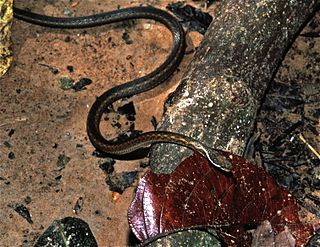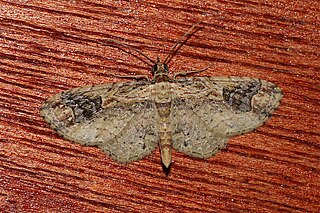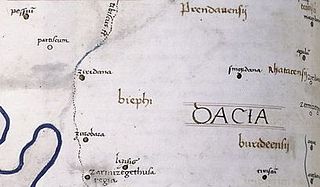
Pecica is a town in Arad County, western Romania. In ancient times it was a Dacian fortress called Ziridava and today it is an important archeological site. Situated at 25 kilometres (16 mi) from Arad, it was declared a town in 2004. Its administrative territory extends into the Arad Plateau. The town administers three villages: Bodrogu Vechi (Óbodrog), Sederhat (Szederhát) and Turnu (Tornya).

Hebius khasiensis, commonly known as the Khasi Hills keelback or Khasi keelback, is a species of colubrid snake endemic to southeastern Asia.
Stoliczkia khasiensis is a species of snake in the family Xenodermidae. It is endemic to Meghalaya, Northeast India. The type locality is Khasi Hills.

Ziridava is a genus of moths in the family Geometridae.

Retinia is a genus of moths belonging to the subfamily Olethreutinae of the family Tortricidae.

Eupitheciini is a tribe of geometer moths under subfamily Larentiinae, often referred to as pugs. The tribe was described by Tutt in 1896.

Zurobara was a Dacian town located in the northwest of today's Romanian Banat. It was positioned by the Tibiscus (Timiș) river, north of Sarmizegetusa Regia and south of Ziridava.

Şanţul Mare is an important archaeological site located 9 km west of Pecica, Arad County, Romania, near the border with Semlac commune and 600 m from the river Mureș.

Ion Horaţiu Crişan (1928–1994) was a Romanian historian and archaeologist. He conducted research in South-Eastern and Central Europe, focusing on Geto-Dacians and Celts.

Ziridava was a Dacian town located between Apulon and Tibiscum, mentioned by Ptolemy in the area of the Dacian tribe of Biephi.
Ziridava xylinaria, the indistinct carpet, is a moth in the family Geometridae. The species was first described by Francis Walker in 1863. It is found in Sri Lanka, India, Hong Kong and on Peninsular Malaysia, Borneo, Java and possibly the Philippines and Sulawesi.
Ziridava gemmata is a moth in the family Geometridae. It is found on the Solomon Islands and the Bismarck Archipelago.
Ziridava dysorga is a moth in the family Geometridae. It is found on Samoa and the Cook Islands.

Ziridava kanshireiensis is a moth in the family Geometridae. It is found in Taiwan and on the Philippines, Borneo and Peninsular Malaysia.
Ziridava baliensis is a moth in the family Geometridae. It is found on Bali and Flores.
Ziridava rubridisca is a moth in the family Geometridae. It is found in southern India and Sri Lanka.
Ziridava rufinigra is a moth in the family Geometridae first described by Charles Swinhoe in 1895. It is found on Borneo and in India, New Guinea and the Australian state of Queensland.
Ziridava asterota is a moth in the family Geometridae first described by Louis Beethoven Prout in 1958. It is found on Borneo.






